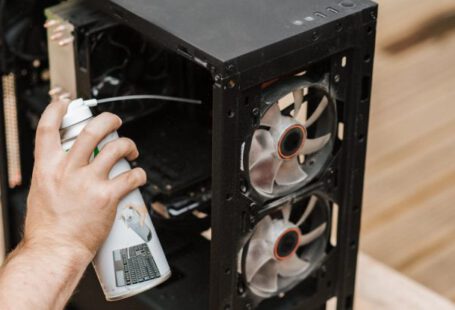Maintaining a dust-free environment for your PC is crucial to ensure optimal performance and longevity. Dust build-up can clog the internal components of your computer, leading to overheating and potential hardware failures. By following some best practices for dust-proofing your PC, you can prevent these issues and keep your system running smoothly.
—
**Choose the Right Location**
The first step in dust-proofing your PC is selecting an appropriate location for it. Avoid placing your computer near windows, doors, or vents where dust can easily enter. Opt for a clean and well-ventilated area with minimal foot traffic to reduce the amount of dust that settles on your PC.
—
**Use Dust Filters**
Investing in dust filters for your PC case can significantly reduce the amount of dust that enters your system. Dust filters are designed to trap particles before they can reach your internal components, helping to keep your PC clean and dust-free. Make sure to clean or replace the filters regularly to maintain their effectiveness.
—
**Regular Cleaning Routine**
Establishing a regular cleaning routine is essential for keeping your PC dust-free. Use a can of compressed air to blow out dust from the vents, fans, and other hard-to-reach areas inside your computer. Be gentle when using compressed air to avoid damaging any sensitive components. Additionally, wipe down the exterior of your PC with a microfiber cloth to remove any surface dust.
—
**Manage Cable Clutter**
Cable management plays a significant role in dust-proofing your PC. Tangled and messy cables can trap dust and hinder airflow, leading to increased dust accumulation inside your computer. Use cable ties or Velcro straps to organize and secure your cables, keeping them neat and out of the way to promote better airflow and reduce dust build-up.
—
**Elevate Your PC**
Elevating your PC off the floor can help minimize the amount of dust that enters your system. Placing your computer on a desk or elevated surface can prevent dust from being kicked up from the floor and settling inside your PC case. Additionally, using a stand or platform with feet can improve airflow around your PC, further reducing the risk of dust accumulation.
—
**Monitor Internal Temperatures**
Monitoring the internal temperatures of your PC can help you identify potential issues related to dust build-up. Use software tools to track the temperature of your CPU and GPU, and take note of any significant increases over time. Elevated temperatures can indicate a build-up of dust that is impeding airflow and causing overheating. Addressing these issues promptly can prevent damage to your components.
—
**Consider Positive Air Pressure**
Creating positive air pressure inside your PC case can help prevent dust from entering through unfiltered openings. By installing additional intake fans or adjusting existing fan configurations, you can create a positive airflow that pushes air out of the case, minimizing the intake of dust and other contaminants. Be mindful of the balance between intake and exhaust to maintain optimal airflow.
—
**Conclusion: Maintain a Clean and Dust-free PC**
In conclusion, dust-proofing your PC is essential to ensure its longevity and performance. By following these best practices, such as choosing the right location, using dust filters, establishing a regular cleaning routine, managing cable clutter, elevating your PC, monitoring internal temperatures, and considering positive air pressure, you can effectively minimize dust build-up and keep your computer running smoothly. Prioritizing cleanliness and airflow will not only extend the life of your PC but also improve its overall performance and reliability.





